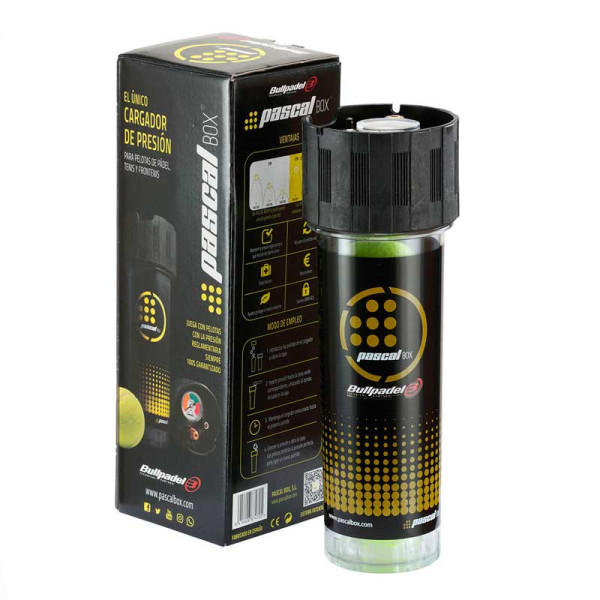This Pascal Box 3B ball pressurizer is designed to extend the life of your paddle balls. Unlike other pressurizers, it is the only pressurizer for sale that recovers after each game the perfect pressure of your ball.
This ball pressurizer includes vaseline canister for maintenance and inflation pump.
Pascal Box On Offer User Guide
1. Introduce the balls into the container and close the lid firmly, it is necessary that the balls introduced are from the same original pack.
2. Remove the plug from the injection valve and insert the pump into it with the lever lowered. Raise the lever and inject pressure until the indicator needle reaches the Green zone. Lower the lever, remove the pump and replace the plug.
3. Keep the charger pressurized until the start of the match. To fully recover the pressure lost during a match takes between 12 and 72 hours.
Important: Remove all pressure before opening the charger to avoid possible damage by pressing the center of the valve.
Approx. size: 29 cm long x 10cm in diameter.
Weight approx: 470 gr.
What is the Pascal Box padel ball pressurizer? Review
The Pascal Box is a system that will guarantee that your balls always have the regulatory pressure and the perfect bounce.
PascalBox causes the pressure inside to be higher than that of the outside. That is why it is normal for the lid to be a little hard when opening if the boat has been pressurized for several days. In any case, this variation in pressure should only offer a little resistance, if you have trouble opening the lid it is a sign that you are tightening it too much.
How to open and close Pascal Box 3B from Bullpadel? Our opinion
You just have to screw the lid of Pascal Box until it makes contact at the end of the thread, at that point it is only necessary to turn the width of a finger so that it is tight. Squeezing too hard can subject the lid to excessive fatigue, which could reduce its long-term strength.
If you notice that your Pascal is not completely sealed when you close the lid, try to clean the gasket with a cloth or a dry cloth, it is very likely that some grit has been installed in it through which the air is filtered. In any case, over-tightening the lid is never the solution.
If from time to time you do a little maintenance of your Pascalbox , cleaning and greasing the gasket, you should never have problems with its closure.
Remember to also use the air exhaust valve before opening the lid, to avoid subjecting it to excessive force.
How to recover the balls with the Pascal box 3B padel pressurizer?
1. After inserting the balls into the container and closing the lid firmly, inject, with the help of the pump, the necessary pressure to bring the indicator up to 3/4 of the orange zone. Keep the charger at this point for 72 hours to recharge the inside of the ball with this level of pressure.
2. Re-inject pressure until the indicator is at the beginning of the green area of Padel (regardless of the type of ball). Keep the pressurized charger at this point for another 72 hours.
3. Once step 2 is completed, take the needle to the green area corresponding to the type of ball and keep the charger at that point for 72 hours. The balls would have regained regulatory pressure and voted like day one.
Important note: If at any point in this procedure you notice that a ball is deformed, it is a sign that it is no longer in good condition to be recovered, so it would have to be thrown away.
How to maintain or clean the Pascal Box Padel pressurizer Bullpadel?
With use, the container is filled with sand and impurities. When sand is lodged in the O-ring, small pressure losses can occur. To avoid this, you have to clean and lubricate this gasket (use grease, oil or petroleum jelly). Our recommendation is to lubricate the gasket with petroleum jelly abundantly (especially in the first uses).
If after a while (since the last pressurization of the charger) we detect that it has lost pressure, it may be due to one of these three causes that we detail below:
1. That the lid has not been closed firmly enough.
2. That the joint between container and lid houses sand or impurities.
3. Due to heavy use, the metal part inside the injection valve has been slightly loosened.







